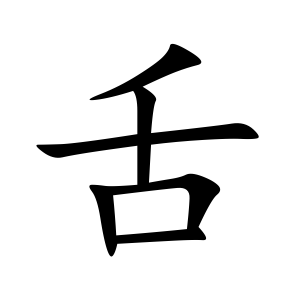舌
- tongue;
It represents the body part "tongue."
Etymology
The Shuowen Jiezi explains that 舌 (tongue) is a phono-semantic compound character composed of 干 (shield, representing sound) and 口 (mouth, representing meaning). However, another hypothesis is that it is an ideogram picturing a tongue protruding from the mouth, with the tongue tip split like a snake’s tongue.
Usage in Korean
When used as a radical, it generally indicates meanings related to the movement of the tongue or the sense of taste.
Many characters containing 舌, such as 活, 刮, 括, 話, and 适, have pronunciations involving 'hwal' or 'gwal,' but their phonetic component is not actually 舌 but 𠯑 (a character meaning "to block the mouth," composed of 氏 under 口).
This character is not used independently but served as a phonetic component in those characters. Over time, during the transition from clerical script to regular script, 𠯑 was replaced by 舌.
In Taiwan, this distinction is preserved in handwriting: the original 舌 begins with a horizontal stroke, whereas the 舌 derived from 𠯑 begins with a slanted stroke.
Alternative forms
In Traditional Chinese (Taiwan, Hong Kong and Macao), this character is written with 干 as the upper component, which is also the historical form found in the Kangxi dictionary.
In Simplified Chinese, (mainland China and Singapore), Japanese Kanji, Korean Hanja and Vietnamese Nom script, this character is written with 千 as the upper component.
Characters with 舌
- 竹十口 (HJR)
- ⿱ 千 口 (G J K V)
- ⿱ 干 口 (H T)
